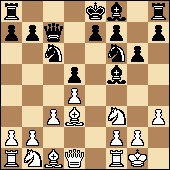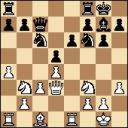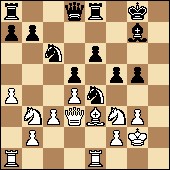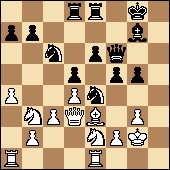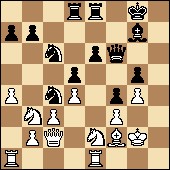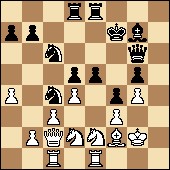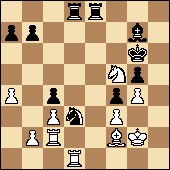As the final day of the Dortmund tournament dawned, there was still an outside chance at a three-way tie for first. Ruslan Ponomariov was leading with a score of 6-3, while Le Quang Liem was tied with Shakhriyar Mamedyarov at 5-4. Le was paired against Ponomariov, which gave him an excellent chance at determining his own fate. He had already beaten Ponomariov once — but that was as White, and now Le would have to do it again as Black. For Mamedyarov, the odds were even longer: not only would he have to root for Le to upset Ponomariov a second time, but he would also have to beat Vladimir Kramnik as Black! Not exactly a likely possibility.
To tell you what happened, I will once again present my translation of grandmaster Sergey Shipov’s online commentary. The original Russian commentary can be found here at the Crestbook website. You can also play the game through on an interactive board. For best results, I suggest opening the Crestbook site in one window while keeping this translation open in another one.
Without further ado, I turn the podium over to Sergey Shipov. — DM
Hello, dear viewers! The tournament in Dortmund is already coming to an end. This is grandmaster Sergey Shipov, commenting on the final round for you. Ponomariov is leading Le and Mamedyarov by a point. The leader, of course, would be happy with a draw, but why not play for a win with White? A great deal will depend on how the opening turns out. If the Vietnamese grandmaster makes an inaccuracy, then the Ukrainian is hardly likely to deny himself the pleasure of a serious battle. In the final analysis, Ruslan is a warrior, not an accountant. He knows how to take risks, keeping a cool head in any kind of complications.
In principle, no matter how today’s game ends, Ponomariov and Le can be considered the stars of the tournament. Ruslan reminded all of his skeptics of his honored past, and proved that he still has a good future. And Le managed in his very first opportunity (which is extremely rare) to achieve an excellent result in a tough round robin tournament. I think that he will now be invited to the most prestigious competitions. It’s immediately obvious that he is a lad with bright prospects, and also it will be very useful for organizers to embrace the new star from Asia — it will increase the press’s interest in their tournaments.
Ponomariov, R. – Le Quang Liem
Dortmund 2010 (round 10), 7/25/2010
1. e4 …
It is pleasant to see that there are still people who will vary their serve. Ruslan chooses between 1. e4 and 1. d4 depending on the opponent. Such a breadth of openings demands a great deal of work. But it pays off …
1. … c6 2. d4 d5
The Caro-Kann Defense.
3. ed cd 4. Bd3 …
A modest variation that has been known since the end of the 19th century. Alapin, Teichmann, and other classics played this way. The Panov attack, 4. c4, is more aggressive.
4. … Nc6 5. c3 Nf6 6. h3 …
White interferes with the white-squared bishop’s emergence into the world. If 6. Nf3 Bg4! Black doesn’t even have the slightest problem.
6. … Qc7
Le tries to rule out any strategic risk. With the text move he prevents the deployment of the white Bishop to f4.
Objectively speaking, the most logical continuation is 6. … e5 7. de Nxe5, but not everybody likes to play with an isolated pawn. It demands great precision and energy.
7. Nf3 g6
The black-squared bishop finds a way of developing that does not interfere with his white-squared compatriot’s search for employment. 7. … e6 would be positional capitulation.
8. O-O Bf5
The slight weakening of the pawn structure in case of a trade on f5 is a small price to pay for the successful development of the queenside. The idea is far from new. This is the way that Salo Flohr used to play more than half a century ago. And he had many followers. Ruslan undoubtedly is fully up-to-date on the theory of this line. And he probably has a couple of stones up his sleeve — that is, his own innovations. Nevertheless he is taking his time over this move.
9. Re1 …
The simplest, but not the most ambitious continuation. Ponomariov clearly prefers to play with an extra reserve of solidity.
The more principled move is still 9. Bxf5 gf 10. Re1 e6. For starters I will show you the source game:Â 11. Nbd2 Bd6 12. b3 Rg8 13. c4 Ne4 (here is the advantage of the appearance of a Black pawn on f5) 14. cd Nc3! 15. Qc2 Ne7 16. Nc4 Ncxd5 17. Nfe5 Ng6 18. Nxd6+ Qxd6 19. Nc4 Qc6 20. Qxf5 Nh4 21. Qxh7 O-O-O and Black has a dangerous attack for the sacrificed pawn, A. Tolush – S. Flohr, Kiev 1944.
But here is an example from our days: 9. Bxf5 gf 10. Re1 e6 11. c4 (playing for the initiative) 11. … dc 12. Nc3 O-O-O 13. Qa4 Nd5 14. Qxc4 Kb8 15. Bg5 Be7 16. Nxd5 Rxd5 17. Bxe7 Nxe7 18. Qxc7+ Kxc7 19. Ng5! Rg8 20. Nxf7 Rb7 21. Rac1+ Kb8 22. Ne5 Rxd4 23. Rc4, and White achieved a lasting advantage in the endgame, J. Ehlvest – P. Harikrishna, Merida 2008.
9. … Bxd3 10. Qxd3 Bg7
Having successfully traded the traditional problem bishop, Black completes his development without interference. He should not experience any difficulties.
11. Nbd2 O-O 12. Nb3 …
White still has to find a place for his bishop on c1. The optimal position — on the h2-b8 diagonal — is impossible for the time being. Meanwhile, what should Black do? For now, breaking in the center is unrealistic, and also risky. He can try to strengthen the e4 square by playing … Nf6-e4 and … f7-f5. Or he could like an old man prepare a minority pawn attack on the queenside. He needs to think … The time is 1:35-1:29.
12. … e6
A useful, generally strengthening move — the analogue of Vitamin C. He will choose a plan later …
In the game V. Ivanchuk – A. Kovchan, Sochi 2010, Black declared his intentions immediately: 12. … Ne4 13. Ng5 Nxg5 14. Bxg5 h6 15. Bh4 e6 16. Bg3 Qd8 17. Re2 Na5 18. Rae1 Nxb3 19. ab Qb6 20. Qc2 a5 with a playable position.
13. a4 …
A novelty — a bland prophylactic move. It’s played so that Black cannot even think about any attacks on the queenside. The bishop will rest for a while on c1, in order to be able to come out in one fell swoop in case of a knight trade on g5.
An earlier game went 13. Be3 Ne4 14. Ng5 Nf6 (at this point, lovers of chess artistry are probably grimacing) 15. Qd2 h6 16. Bf4 Qe7 17. Nf3 Ne4 18. Qd3 Rac8 19. Nfd2 Nd6 20. Bxd6 Qxd6 21. Nf3 Rc7 22. Qe3 b6 23. Ne5 Kh7 24. Kh1 Bxe5 25. de Qe7 and as a result of the virtuoso play of both sides, we have reached a roughly equal position, W. Kruszynski – K. Pytel, Gdynia 1973.
[Translator’s note: Do I need to tell you that Shipov is joking here? — DM]
13. … Rfe8
Another clever, non-juvenile move. Believe it or not, Black is deliberately defending his e6 pawn! After 13. … Ne4 14. Ng5 the move … f5 would be impossible because of 15. Nxe6!
14. g3 …
Here, however, I am forced to abandon my jocular tone. This move was played with juvenile naïvete! Ruslan does after all want very much to bring his bishop out to a promising diagonal. However, I’m afraid that the installation of the knight on e4 will give Black weighty chances. With the pawn on g2 it was possible to think about poking the knight with f2-f3. But with the pawn on g3 — no way!
It’s true that it’s not so easy for me to find a sane alternative. I was considering the original idea of sending the knight into exile on the side of the board with 14. Nc5 b6 15. Na6! As strange as it may seem, this seems to bring White some benefits: 15. … Qb7 (or 15. … Qd6 Ne5! or 15. … Qe7 16. Ne5! Nxe5? 17. de Ne4 18. Rxe4! or 15. … Qe7 Bg5!) 16. Qb5 Ne4 17. Bf4, and it is extremely difficult for Black to extricate himself from the bind on the queenside.
14. … Ne4
Of ourse.
15. Bf4 …
Both sides are making their secret wishes come true, without doing anything to hinder one another.
15. … Qd8
A careful move, with an underline under the word “careful.”
First of all, a retreat to d7 or e7 would have made sense, not breaking the connection between the rooks. Secondly, at a minimum it would have been worth spending a couple of minutes on the interesting jab 15. … e5, with the idea of a double attack by the queen on b3 and f2. But with precise play White can repel the attack: 16. de! Qb6 17. Qc2 Nxe5 (17. … Rac8 18. a5!) 18. Nxe5 Bxe5 19. Be3! Qc7 20. Rad1. However, I would not venture to say that he has an advantage in this position. The weakness of the pawn on d5 is compensated by Black’s active piece play. The knight on e4 all by itself counts for a lot…
16. h4 …
Ponomariov’s treatment. Apparently he decided that Le put his queen on d8 specifically to drive the White bishop from its beautiful post by means of the move … g6-g5. By the way, it may well be this is correct … But note the fact that one more White pawn has been put on a dark square. With dark-squared bishops on the board, that is a fairly risky strategy … But of course, Ruslan sees further. Besides the static considerations in the position there are also lots of dynamic factors.
If he wanted a guarantee of keeping the bishop on its indicated diagonal, he could have played 16. g4. But not everyone would be willing to weaken the king’s defenses in such a way.
16. … h6
The Vietnamese grandmaster indirectly confirms my suspicions. The resource … g6-g5 is still on the docket!
17. Kg2 …
A very distinct warning to his opponent: Okay, son, let’s stop joking around. Otherwise the Black king will have visitors on the h file.
17. … g5
As you can see, Le is not one of your timid soldiers. He is fighting bravely and with a clear goal in mind. He set himself a goal and he is striving for it without regard for any obstacles.
18. hg …
There is no point in avoiding the trade — 18. Be3 f5!
18. … hg 19. Be3 …
Unsatisfactory was 19. Be5 because of 19. … f6!
19. … f5
Exactly the right time! Black first drove his adversary away from his control of the square e5, and only then carried out his intention of seizing more space. There’s nothing you can say — Black has played very sensibly. Assuming, of course, that White doesn’t catch him in some tactical faux pas. There is plenty of time: 1:07-0:54.
In my opinion, Black has excellent prospects. It is easy and pleasant to play with a knight that cannot be ousted from e4. It is more difficult to play the White side … which is confirmed by the long deliberation of the Ukrainian grandmaster. His strategy has led to a dead-end. Probably he will have to move the knight away from f3 and prepare the nudge f2-f3. Risking the life of his king.
20. Ng1 …
I did not expect that my advice would be carried out so literally. White is now ready to play f2-f3. And it’s even more likely that he is planning a preparatory Ng1-e2, in order to make the sacrifice of the knight on g3 less of an issue. The only remaining question is whether this voluntary abandonment of the center by White’s knight might encourage Black to blow up the position by playing 20. … e5.
I looked at the variation 20. Nfd2 Qf6 21. f3 Nxg3 22. Kxg3 f4+ 23. Kf2 fe+ 24. Rxe3 Ne7 25. Rg1 Ng6 26. Ke1 Nf4 27. Qc2 e5 28. Kd1! and it seems as if White’s king has managed to escape from the inferno on the kingside in time.
Next I took a look at the superficially ugly idea of trading on e4 — 20. Nfd2 Qf6 21. Nxe4 de 22. Qd2 f4 23. gf Qf5 and discovered that besides the perpetual check (after 24. fg) White also has the interesting resource 24. Rg1!? However, Black can also be clever: 24. … Rad8, preparing a total opening of the center. Very complicated variations! Over the board you really can’t grasp everything.
20. … Qf6
Reasonable restraint. It’s better to strike the blow when it is guaranteed to produce the desired effect.
It was not at all easy to analyze the move 20. … e5 to a conclusion. There are too many branches … Here is a small illustration:
21. f3 (21. de Nxe4 22. Qd1 Nc4 etc. does not look good, and risky is 21. Ne2 f4 22. f3, for example 22. … Nd6 23. de Nxe5 24. Qxd5+ Ndf7 25. Qxd8 Nxd8 26. gf Nd3 winning an exchange) 21. … Nxg3 22. Kxg3 f4+ 23. Kg2 fe 24. Rxe3 ed 25. Rxe8+ Qxe8 26. Nd4 and White holds.
21. Ne2
Here 21. f3 was clearly premature because of 21. … Nxg3!
21. … Rad8
Solid grandmaster play. Black brings up his final reserves toward the center. Now he can fight with nothing held back! The time is starting to “squeeze” the players a little bit: 0:44-0:32. One more serious deliberation and time pressure will become a reality.
22. f3 …
It’s time. Otherwise Black would play … e6-e5 with a terrible initiative. After the text move, I am starting to have a sneaking suspicion: does Black really need to move his knight from e4?
22. … Nd6
Le decides not to inquire about the details. He redirects his evicted knight toward c4.
I analyzed the waiting move 22. … Kf7 and found an elegant tactical topping with 23. fe fe 24. Qd2? (24. Bxg5 would put up more resistance) 24. … Qf3+ 25. Kg1 Rh8, and White gets mated.
However, in chess you are not obliged to accept a sacrifice. On 22. … Kf7 23. Rh1! looks perfectly good.
23. Qc2 …
Ponomariov does not object. He could have prevented the incursion on c4 with 23. Nd2, but the position of the knight on d2 is rather passive. For example, in case of … e6-e5 he is no longer able to move to d4.
23. … f4
Every secret is revealed sooner or later. It turns out that the sprightly knight is heading not for c4, but to f5. Closer to the White king.
24. Bf2 …
Modestly but solidly played. In the variation 24. gf Nf5 25. Qd2 Nh4+ 26. Kf2 Black would have played the thunderous move 26. … e5!! with a murderous attack.
24. … Nc4
Every move a surprise. I’ve already stopped trying to guess the moves! I am simply sitting here and looking at the screen, and feeling satisfaction at the brilliant and substantive play of the clever opponents.
Just for the sake of curiosity I analyzed the barbaric continuation 24. … e5 25. de Nxe5 with the intention of reaching the square f3. The play could continue 26. Nbd4! (There were more than enough ways for White to go wrong: 26. g4? Nxg4! or 26. Bd4? Nf5! or 26. Ned4 g4!) 26. … fg 27. Nxg3 g4 28. fg Nxg4 29. Bg1. As you can see, the White king is somehow alive and well even in the wide-open spaces. By the way, his Black colleague is not exactly ensconced in a warm and cozy sanctuary.
25. g4 …
Ruslan probably could not conceal a sigh of relief. He has finally managed to stabilize his king’s pawn shelter.
25. … Kf7
A move with many plans. One of the ideas is a crafty trade of queens on g6. The weakness of the pawn on b2 would be perceptible. Note also that Black always has the sharp break … e6-e5 in reserve, which is capable of sharply changing the character of the game. White still stands worse.
26. Nd2 …
A natural desire to get rid of the terrorist.
26. … Qg6
A strong riposte.
27. Rac1 …
An attempt to defend everything without changing the structure. After 27. Qxg6+ Kxg6 28. Nxc4 dc White’s minor pieces are like prisoners of the Bastille.
27. … e5
A powerful and quite timely blow. Le has once again waited until the precise moment when his adversary moved a minor piece away from a key square, and then, finally, struck his blow. In this case, I’m talking about the knight at b3, which for a long time was guarding the square d4. The Vietnamese grandmaster’s advantage has become noticeable. But at the same time, his disadvantage on the clock is also noteworthy: 0:31 – 0:13. We will now find out which is better from a practical point of view: to play slowly and very powerfully, or to play quickly and … not too badly.
28. Qxg6+ Kxg6 29. Nxc4 dc
The elimination of the hyperactive knight has not come for free. The rook on d8 now enters the game actively. White is cramped and doomed to a passive defense.
30. Red1 …
The most stubborn move. Only a crazy man would trade on e5, allowing the enemy knight into d3.
30. … ed?!
The onset of time trouble has already made itself known. A stronger move was 30. … b6!, really putting the clamps on White. He is simply not in a condition to undertake anything. The cheap seats are full! With the text move Le begins a forced variation which, it seems, makes White’s job easier.
[Translator’s comments: Actually, a chess comment here. I wish Shipov had said a little bit more about what Black’s plan should be. After all, White could just wait with Bf2-g1 or Rc1-c2. It isn’t a complete zugzwang. But still, his overall point that Black does not to be in a hurry here is certainly right on the money.
By the way, I think Shipov’s comment about the “cheap seats” is meant to imply that the White pieces are so badly posted they are like people sitting in the cheap seats in a concert hall. However, I could be wrong about this interpretation. The actual word he used was “parterre.” — DM]
31. Nxd4 Ne5
The idea is understandable — he wants to gallop with his horse into d3. But White’s pieces are also improving their positions.
32. Nf5 …
Could the White knight have dreamed of such a career just a few moves ago?
32. … Nd3
But for the time being, the victory of the Black cavalry is a little bit more significant.
33. Rc2 …
White has managed to defend all of his weaknesses in time.
33. … Bf6
Now the time scramble begins, and Black’s advantage begins to evaporate like smoke. 33. … Re6 was stronger, with the idea of doubling rooks and invading on e2.
34. Rh1 …
Clearly an unanticipated resource. White’s rook threatens to infiltrate the body of the Black army.
34. … Rh8 35. Rxh8 …
Ponomariov is playing very rapidly — clearly trying to drive his opponent into even more serious time pressure. The times is 0:25 – 0:07.
35. … Bxh8 36. Re2 …
Ruslan’s playing strategy is aided by the fact that White’s moves are simple and obvious.
36. … Nxf2
Le is swimming, as they say — he is desperately grasping at all of the obvious possibilities. Once again it would have been hard to imagine a few moves ago that White would manage to trade his utterly passive bishop for the powerful Black knight. On the other hand, in this position 36. … b6 would also not have accomplished anything. In that case White would whip up counterplay with 37. a5! ba 38. Re6+ followed by 39. Ra6.
37. Kxf2 Bf6
The position is roughly equal. It’s hard for either side to undertake anything active without exposing themselves to obvious risks.
38. Re4 …
Pointing out a flaw in the opponent’s position.
38. … Rd2+Â
A symmetric answer. Everybody has his own problems …
39. Re2 Rd3Â
If he trades rooks, Black runs the risk of losing the c4 pawn.
40. Re4 Rd2+ 41. Re2 …
The time control is past, and the result of the game has become obvious.
41. … Rd3 42. Re4 ½-½
A draw! Ruslan Ponomariov has become the winner of the Dortmund 2010 tournament. Bravo! It has been a long time since he won such a powerful tournament… However, his second place at the World Cup 2009 was no less weighty a success, maybe even more so. But still, the fact of winning a tournament, and winning it outright, is exceptionally important for the psychology of a chess player. I hope that Ruslan will soon return to his peak form and will once again be in the running for the champion’s title. He deserves it…
All the flattering evaluations that I offered about Le’s play before this game, I can now definitely multiply by two! Today’s game forced me to look at the Vietnamese lad with new eyes. It turns out that he is able as Black to gradually, methodically, and even almost imperceptibly outplay even a strong, elite grandmaster! This is very clear evidence of unusual ability, a subtle understanding of chess and the high level of play that Le has already achieved. I can predict that this player has arrived in the elite for real and for a long time.
Mamedyarov today lost to Kramnik unexpectedly quickly, without even a murmur of protest. Apparently he must have run into some home preparation. But even this spoonful of honey will not sweeten the barrelful of tar that the ex-world champion had to swallow. He gave a poor performance. A result of 50 percent in this group is not worthy of Kramnik. Oh well, even the greats have some dark stripes in their careers. As for the misadventures of Naiditsch and Leko, I think I will not dwell on them in order not to rub salt in their wounds.
And so, the tournament is over. This has been grandmaster Sergey Shipov, the resident expert of the website www.crestbook.com, commenting on it for all the fans and connoisseurs of chess. Thank you for your attention, and until next time…
P.S. I also would like to thank my colleagues Colin McGourty and Dana Mackenzie for their high-quality translations of the online commentaries into English.
[Translator’s note: * blush * — DM]
